| 12 January |
• yesterday • tomorrow |
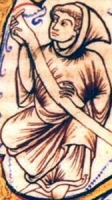
• Aelred of Revesby
• the English Saint Bernard
• Aethelred, Ailred, Eilred, Ethelred, Aelredus, Alfred, Alred, Ethelredus
• 3 February (Cistercians)
• 3 March (dioceses of Hexham, Liverpool and Middlesbrough in England)
Son of Eilaf, a priest during a period when English priests were allowed to marry, and keeper of the shrine of Hexham. Master of the household of the court of King David of Scotland. Known for his gentle spirituality and his personal austerity amid the court life. David wanted to make his friend a bishop, but instead Aelred left Scotland in 1134 to become a Cistercian monk at Rievaulx, Yorkshire, England. Master of novices. First abbot of a Cistercian monastery in Revensby, Lincolnshire, England in 1142. Abbot of Rievaulx in 1147, which made the superior of all Cistercians in England, and kept him much on the road, travelling from house to house, preaching throughout England and Scotland. Peacemaker among the Picts in Galway, ending disputes and revitalizing the faith in the area. He composed sermons and prayers, wrote works on the spiritual and aescetic life, wrote on the lives of King David of Scotland, Saint Ninian and Saint Edward the Confessor, and was considered a living saint by those who knew him.
1110 at Hexham, England
• 12 January 1167 at Rievaulx Abbey, Yorkshire, England of kidney disease
• buried in the Rievaulx Chapter House
• relics translated to the abbey church and enshrined behind the high altar in 1191
• never formally canonized
• cultus and devotion developed immediately after his death
• cultus approved by the Cistercian general chapter in Cîteaux in 1476
• against kidney disease
• against kidney stones
• abbot holding a book
• abbot holding a scroll
• A Certain Wonderful Miracle
• Genealogy of the Kings of the English
• Jesus as a Boy of Twelve
• Lament for the Death of King David of Scotland
• Mirror of Charity
• On Spiritual Friendship
• On the Saints of Hexham
• On the Soul
• Pastoral Prayer
• Relatio de Standardo
• Rule of Life for a Recluse
• The Life of Saint Edward, King and Confessor
• The Life of Saint Ninian
One who speaks the word of God to others ought not aim at vaunting his own knowledge but at discerning how he can build up his hearers. And with a motherly compassion for weaker minds he ought, I might say, prattle to them, descending to the use of baby talk. But the limit of my gifts make it necessary that my hearers stoop down to the poverty of my words. - Saint Aelred
How I savor it when I see the Lord of all majesty showing himself as far as bodily exertion and human emotion are concerned not like the strong but the weak. What a comfort it is to me in my weakness! Truly this weakness of my Lord without doubt brings me strength and stability in my weakness. I am entrusted with the care of my brother's body and soul (for I do not love the whole man if I neglect anything belonging to either - for it is very difficult for the mind not to be tempted when the flesh has too much to suffer). If I see him in distress, whether it be on account of the austerity of the food or because of work or the vigils - if, I say, I see that he is tormented in body and tempted in spirit, if I see him in such affliction and…do not on occasion accommodate myself to the infirmities of the weak I am not running in the fragrance of Christ's ointments but with the harshness of the pharisees. - Saint Aelred
https://catholicsaints.info/saint-aelred/
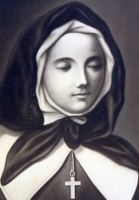
• Margaret Bourgeoys
• Marguerite Bourgeoys
• Marguerite Bourjeoys
The sixth of twelve children of devout parents. When Marguerite was 19 her mother died, and the young lady cared for her younger brothers and sisters; her father died when she was twenty-seven. The family raised, Marguerite prayed to know what to do with her life. The governor of Montreal, Canada, was in France looking for teachers for the New World. He invited Marguerite to come to Montreal to teach school and religion classes. She agreed and spent the rest of her life in North America.
Marguerite gave away her share of her parents' inheritance to other members of the family, and in 1653 sailed for Canada. She began construction of a chapel to honor Our Lady of Good Help, and opened her first school in 1658. She returned to France in 1659 to recruit more teachers, and returned with four; in 1670, she went to France again, and brought back six more. These brave women became the first sisters of the Congregation of Notre Dame.
Marguerite and her sisters helped people in the colony survive when food was scarce, opened a vocational school, taught young people how to run a home and farm. Marguerite's congregation grew to 18 sisters, seven of them Canadian. They opened missions, and two sisters taught at the Native American mission. Marguerite received the first two Native American women into the congregation.
In 1693, Mother Marguerite handed over her congregation to her successor, Marie Barbier, the first Canadian to join the order. Marguerite's religious rule was approved by the Church in 1698, and Marguerite spent her last few years praying and writing an autobiography. On the last day of 1699, a young sister lay dying. Mother Marguerite asked the Lord to take her life in exchange. By the morning of 1 January 1700, the sister was completely well, Mother Marguerite had a raging fever, suffered 12 days, and died on 12 January 1700.
17 April 1620 at Troyes, Aube, France
12 January 1700 at Montreal, Quebec, Canada of fever
31 October 1982 by Pope John Paul II
• against death of parents
• against impoverishment
• against poverty
• people rejected by religious orders
• poor people
Our Lady's love is like a stream that has its source in the Eternal Fountains, quenches the thirst of all, can never be drained, and ever flows back to its Source. - Saint Margaret Bourgeoys
https://catholicsaints.info/saint-marguerite-bourgeous/
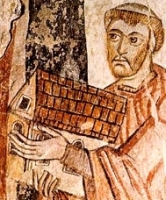
• Benet Biscop
• Biscop Baducing
Anglo-Saxon nobility. Grew up around the court of King Oswy of Northumbria, and held court offices. Following a pilgrimage to Rome he renouced his wealth and position, and dedicated himself to prayer and scripture study. Monk at the monastery of Saint-Honorat near Cannes, France in 666, taking the name Benedict.
In 668 Pope Saint Vitalian sent him and the monk Adrian to advise Theodore, Archbishop of Canterbury until 671. Traditionally introduced the construction of stone churches and glass church windows to England, and brought in many foreign craftsman to do the work and teach the English. Tried to introduce more Roman rituals to English worship. Founded the monasteries of Wearmouth and Jarrow. Built a large library and scriptorium at Wearmouth.
In late life Benedict suffered a painful paralysis, and was confined to his bed for his last three years. He continued to work from his bed, buying books, establishing the Benedictine Rule.
c.628 in Northumbria, England as Benet Biscop
• 12 January 690 of natural causes at Wearmouth, England
• relics at Thorney abbey and Glastonbury, England
• English Benedictines
• musicians
• painters
• Sunderland, England
• Benedictine abbot dressed as a bishop standing by the Tyne with two monasteries nearby
• with the Venerable Bede
https://catholicsaints.info/saint-benedict-biscop/
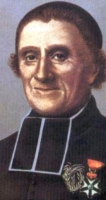
• Peter Francis Jamet
• Second Founder of the Institute of the Good Savior
One of eight children born to a wealthy farm family. Studied at the College of Vire, then the University of Caen. Ordained on 22 September 1787 in the diocese of Bayeaux, France. Chaplain and confessor to the Daughters of the Good Savior in Caen, France in 1790. He tried to continue his studies, but the French Revolution ended the teaching of theology. He was imprisoned for refusing to swear the oath required by the anti-Church Revolutionary authorities, who then dispersed the Daughters community. Upon his released, Father Pierre continued to minister to the sisters and other covert Catholics, conducting Mass in secret. After the Revolution execesses, he devoted himself to restoring and revitalizing the Daughters. Helped found a school devoted to and new teaching methods for the deaf. Rector of the University of Caen from 1822 to 1830. Awarded the Legion of Honour in 1827 in recognition of his good works.
12 September 1762 in Fresnes, Aisne, France
• 12 January 1845 in Caen, Calvados, France of natural causes
• buried in the motherhouse of the Daughters of the Good Savior in Caen
10 May 1987 by Pope John Paul II
https://catholicsaints.info/blessed-pierre-francois-jamet/
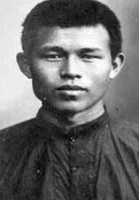
• Benedikto Chunkim
• Benedikto Xunkim
• Nicholas Bunker Kitbamrung
• Nikholas Buykoet Krisbamrung
• Nikola Bunkerd Kitbamrung
One of six children. His parents were converts, and he was raised as a Christian. Entered the Hang Xan Minor Seminary at age 13, and the Penang Major Seminary, Malaysia in 1920. Ordained in the archdiocese of Bangkok, Thailand in 1926. Pastor at Bang Nok Khneuk and Phitsanulok. Missionary to northern Vietnam from 1930 to 1937, working to bring back Catholics who had fallen from their practice due to poverty.
When war broke out between France and Indochina, Nicholas was accused of spying for the French. In 1941 he was arrested and sentenced to 10 years in prison. There he contracted tuberculosis which, with the hardships of prison, eventually killed him, but not before he spent two years bringing the faith to his fellow prisoners, baptizing at least 68. Thailand's first martyr priest.
28 February 1895 at Sam Phran, Nakhon Pathom, Thailand
12 January 1944 of tuberculosis at Bangkok, Thailand
5 March 2000 by Pope John Paul II at Saint Peter's Square, Rome, Italy
https://catholicsaints.info/blessed-nicholas-bunkerd-kitbamrung/
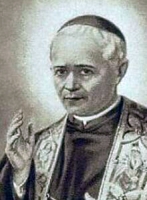
• Anthony Mary Pucci
• Antonio Maria Pucci
• Eustacchio Pucci
• Il Curatino
Second of seven children from a peasant family. His father was sacristan of the local church, but he opposed his son's interest in religious life. At age 18 Eustacchio joined the Servites, taking the religious name of Antony Mary. He studied the classics and theology. Ordained in 1843. Assigned at age 28 as parish priest in the seaside town of Viareggio, Italy where he spent the rest of his life, working 45 years in service to his flock. Called il curatino, "the little parish priest" by his parishioners. Had special devotion to the sick, the aged, and the poor, serving with distinction during two epidemics in the town. Founded a seaside nursing home for children, and served as Servite provincial from 1883 to 1890.
16 April 1818 in Poggiole di Vernio, Italy as Eustacchio Pucci
• 12 January 1892 at Viareggio, Italy
• interred in the church of Sant'Andrea in Viareggio
9 December 1962 by Pope John XXIII
Vernio, Italy
https://catholicsaints.info/saint-antony-mary-pucci/
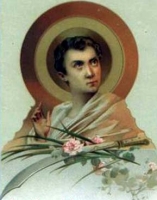
Wealthy and prominent citizen, and a closet Christian. During a persecution in Mauritania, he withdrew to live as a hidden hermit, prayerful and out of harm's way. The authorities wanted to use him as an example, and arrested a relative, threatening him with harm unless Arcadius turned himself in. Arcadius came in from the forests and went straight to court to trade himself for his kinsman. The judge said he would release the prisoners only if Arcadius would publicly sacrfice to a pagan god. Arcadius declined; martyr. As he was mutilated to death, he continued to preach Jesus to the watching pagans.
slowly hacked to death one joint, appendage and limb at a time c.302 at Caesarea, Mauritania (near modern Algiers)
• early Christian martyr with a club in his hand
• early Christian with a lighted taper
• man on a rack
• man with his limbs chopped off
Lord, teach me thy wisdom. - Arcadius's dying words, repeated over and over as he was hacked apart
https://catholicsaints.info/saint-arcadius-of-mauretania/
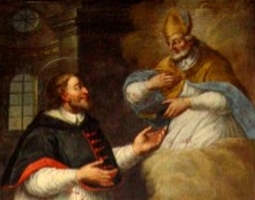
Martin of the Holy Cross
Educated in the monastery of Saint Marcellus at Leon, Spain. Pilgrim to Rome, Italy, and to Constantinople. Augustinian canon regular at Saint Marcellus abbey. Priest. When his monastery was secularized, he entered the collegiate church of Saint Isidore at Leon. Wrote commentaries on the Epistles and Revelations, and discourses on varied subjects. Known during his lifetime for his holiness and ascetical writings.
in León, Old Castile, Spain
• 12 January 1203 at León, Spain of natural causes
• relics enshrined in the San Martin chapel in the collegiate church of León in 1513
• the religious of Saint Isidore's dedicated a chapel to Martin very early, and celebrated his feast each year
• in 1964 the Sacred Congregation of Rites approved his feast for the diocese of León, Spain
https://catholicsaints.info/saint-martin-of-leon/
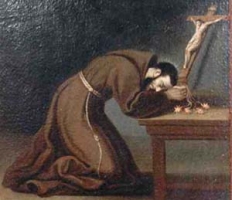
• Bernardo de Corleone
• Filippo Latino
• Philipi Latini
Shoemaker by trade, and considered the greatest swordsman and duelist in Sicily in his day. After mortally wounding a man named Canino in a duel, he sought sanctuary from the law in the church of the Capuchin Friars Minor in Palermo. While hiding there, he had a true conversion, and became a Capuchin lay-brother in 1632, changing his name to Brother Bernardo.
Noted for his extreme austerity and self-imposed penances in an attempt to atone for his earlier life. Had the gift of healing animals by prayer.
6 February 1605 at Corleone, Palermo, Sicily as Filippo Latino
12 January 1667 at Palermo, Sicily
10 June 2001 by Pope John Paul II
https://catholicsaints.info/saint-bernard-of-corleone/

Lucia of Norcia
Born to a wealthy family, Lucia was drawn to religious life as a child, and at age 15 she made private vows. With seven like-minded friends, she founded a religious community that set such an example that on 28 January 1386 the City Council voted to help them, and the group moved to the convent of San Girolamo. She founded a monastery and the church of Santa Maria in the Valcadara community of Norcia, Italy in 1390. In 1407 the group received approval, taking the rule of the Poor Clares.
1370 in Norcia, Perugia, Italy
• 12 January 1430 of natural causes
• relics enshrined in the monastery of the Poor Clares of Santa Maria della Pace in 1637
https://catholicsaints.info/blessed-lucia-of-valcaldara/
• Martinian of Byelozersk
• Martinian of the White Lake
• Martinian of the Black Sea
• Martinien, Martinianus
7 October (discovery of his relics)
Born to a poor family, his parents entrusted the boy Martinian to the monastery at White Lake. Spiritual student of Saint Cyril. Monk. Priest. Abbot of the Trinity Laura of Saint Sergius. Advisor to the Grand Prince of Moscow. In his old age he retired to the monastery at White Lake.
1398
1483 at the monastery of White Lake of natural causes
https://catholicsaints.info/saint-martinian-of-belozersk/
• Johann Kaspar Kratz
• Joanes Kaspar Kratz
Spent several years as a young adult travelling around Europe. Employee of the Dutch East India Company in 1727. Joined the Jesuits at Macao in 1730. Missionary to the kingdom of Tonkin (modern Vietnam). Ordained in 1734. Arrested in March 1736. Tortured and martyred for his work.
15 September 1698 at Golzheim, Düren, Germany
beheaded in 1737 in Tonkin (modern Vietnam)
https://catholicsaints.info/blessed-john-gaspard-cratz/
Antonio
2 January as one of the Martyrs of Anjou
Married lay man craftsman of the diocese of Angers, France. Martyred in the persecutions of the French Revolution.
26 January 1736 in La Poitevinière, Maine-et-Loire, France
shot on 12 January 1794 in Avrillé, Maine-et-Loire, France
19 February 1984 by Pope John Paul II at Rome, Italy
https://catholicsaints.info/blessed-antoine-fournier/
Cesarie, Cesira
Sister of Saint Caesarius of Arles. Founder of a convent in 512; the house soon grew to hundreds of nuns, many of them widows. Caesaria served as its first abbess. She was devoted to the care of the poor, the sick, and children. Saint Gregory of Tours and Saint Venantius Fortunatus wrote of her gifts.
c.465
c.530 of natural causes
https://catholicsaints.info/saint-caesaria-of-arles/
Founded monasteries and hospices in Italy. Travelled and settled briefly in France. Founded and directed a community of monks at Asana (modern Saint Victorian) in the diocese of Barbastro, in the Spanish Pyrenees. Saint Venantius Fortunatus wrote well of him.
Italian
• c.560 in Spain of natural causes
• relics at Montearagón Abbey, Spain
https://catholicsaints.info/saint-victorian-of-asana/
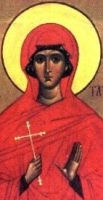
Martina, Tatienne
Daughter of a Roman consul. Tortured and martyred in the persecutions of Emperor Alexander Severus.
beheaded c.226 in Rome, Italy
https://catholicsaints.info/saint-tatiana-of-rome/
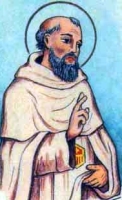
Mercedarian friar involved in the ransoming of Christians enslaved by Muslims. Master-General of the Order on 3 November 1417.
French
12 January 1419 at the monastery of San Martino, Perpignan, France of natural causes
https://catholicsaints.info/blessed-bernardo-de-plano/
Fergeol, Ferréolo
Bishop of Grenoble, France. Killed while preaching to a crowd. Martyr.
• beaten to death with a stick on 12 January 659 on Mount Esson
• buried at La Tronche
1907 by Pope Saint Pius X (cultus confirmed)
https://catholicsaints.info/saint-ferreolus-of-grenoble/
Jesuits priest in 1724. Missionary, assigned to Goa, India in 1733, then in 1734 to Macao to the kingdom of Tonkin (modern Vietnam). Arrested in March 1736. Tortured and martyred for his work.
1708 at Arouca, Portugal
beheaded in 1737 in Tonkin (modern Vietnam)
https://catholicsaints.info/blessed-emmanuel-dabreu/
Joined the Jesuits at Coimbra, Portugal. Missionary to the kingdom of Tonkin (modern Vietnam). Arrested in March 1736. Tortured and martyred for his work.
near Braganza, Portugual
beheaded in 1737 in Tonkin (modern Vietnam)
https://catholicsaints.info/blessed-bartholomew-alvarez/
Jean
Bishop of Ravenna, Italy from 452 for over 40 years. Saved his flock from the ravages of Attila the Hun. Secured better conditions for his people when Ravenna was captured by King Theodoric of the Ostro-Goths.
494 of natural causes
https://catholicsaints.info/saint-john-of-ravenna/
Tygrius
Priest in Constantinople. Active supporter of Saint John Chrysostom during his exile. To silence him, Tigrius was arrested and exiled on trumped up charges of trying to burn down the Constantinople cathedral and senate.
c.405 in Asia Minor of natural causes
https://catholicsaints.info/saint-tigrius/
Lector in Constantinople. Active supporter of Saint John Chrysostom during his exile. To silence him, Eutropius was arrested and exiled on trumped up charges of trying to burn down the Constantinople cathedral and senate.
c.405 in Asia Minor of natural causes
https://catholicsaints.info/saint-eutropius/
Jesuit. Missionary to the kingdom of Tonkin (modern Vietnam). Arrested in March 1736. Tortured and martyred for his work.
Portuguese
beheaded in 1737 in Tonkin (modern Vietnam)
https://catholicsaints.info/blessed-vincent-de-cunha/
Satyre
Destroyed a pagan idol by making the sign of the cross at it. Martyred by the pagans who had worshipped the thing.
Arab
267 in Achaea (in modern Greece)
https://catholicsaints.info/saint-satyrus/
One of a group of 50 soldiers martyred in Africa.
in Africa
https://catholicsaints.info/saint-quinctus-the-soldier/
One of a group of 50 soldiers martyred in Africa.
in Africa
https://catholicsaints.info/saint-biccianus/
One of a group of 50 soldiers martyred in Africa.
in Africa
https://catholicsaints.info/saint-caroticus/
Martyr.
Greece
burned to death in 309
https://catholicsaints.info/saint-peter-of-abessala/
Bishop of Verona, Italy.
late 6th century
https://catholicsaints.info/saint-probus-of-verona/
Martyr.
Tivoli, Italy
https://catholicsaints.info/saint-zoticus-of-tivoli/
A group of 44 Christian soldiers murdered together for their faith in Africa. The only details that survive are four of their names - Castulus, Modestus, Rogatus and Zoticus.
in Africa
https://catholicsaints.info/martyrs-of-africa-12-january/
Ephesus Martyrs
Forty-two monks martyred at a monastery in Ephesus (modern Turkey) during the persecutions of the Iconoclast Byzantine Emperor Constantine V. Their names have not come down to us.
martyred c.762
https://catholicsaints.info/martyrs-of-ephesus/
Iona Martyrs
Thirty-eight monks martyred in Iona, Ireland. Their names have not come down to us.
martyred in 750 at Iona, Ireland
https://catholicsaints.info/martyrs-of-iona/
CatholicSaints.Info Portable Edition